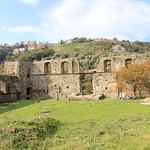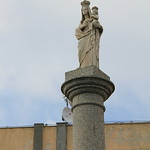
Squares and Fountains
The open-air theatre
The open-air theater “Franco Squillacioti” is of recent construction; its completion goes back to the 2006. It is composed by an ample cavea, made of a colonnade partly coated with travertino plates opportunely shaped and from an ample stage able to host shows of various kind. Under the stage, useful structures to accomodate the various artists are present.

Enrico Fermi Square
It is the central square of the town, the heart of the historical center. It is the place of socialization of all religious, politics and cultural components of the town. The defining buildings, the tiles in local stone that pave it, the façade of the Matrix Church, and a menzalora furnish this piece of the town and create a warm urban intimacy.

Source Pruppo
Outside the inhabited area and absorbed in the green, there is the ancient source Pruppo (Pruppu). It can be reached through the Xχioppu district, taking the road alongside the stream.
It is well documented that in the 1500, in the same area, there was the location called Purpo, whose name then has become Pruppo.
The water of the source crosses two caves that join together just before the entrance. Afterwards, the water gets channelled into a pipe-line inside the artefact made of local granite stone that includes projecting elements. Under the pipe-line, another lithic element takes the water in the side basin.
The source was the place of meetings, socialization and romantic stories.

Source Vrisi
Up to XIX century the towns of Gasperina and Montauro were connected thanks to an ancient road that passed through the Sant’Anna’s Grancia. The water came to the Grancia from the near souce Vrisi (or Brisi), situated to the foot of a forest. At the bottom of it we can find the luxuriant characteristic flora of the damp hilly places. The water of the source is brought in a manufactured article whose central body exhibits bands, an empty top panel, holes for pole; in four different floral motives, situated in the inferior part, some cinnamons are inserted. In the opposite side from the basin, a calcarenite block bears an interpretable incision like “・A・S・S・1694”. The whole construction would have been realized by the Carthusian monks of the near Grangia a the end of ‘600.
Under the road there are the ancient tubs for washing in whose proximities there were the cacinari, that is tubs used for the workmanship of the skins.

Source Vrantoni
On the border with the territory of Montauro and along the provincial road nr. 123 that lies in a varied naturalistic and panoramic environment, the source Vrantoni is located. The water from the site where it surfaces is taken downstream valley through the body of an artifact built in the first years of 1900, and renovated on 2011. Here, there is a pipe from which the water falls intothe underlying granite cup and reaches the contiguous basin. This source, according to the tradition, would have been discovered by a Carthusian monk from the near Grangia of Sant’Anna, whose name was Antonio, from which Vrantoni. For the Gasperina and Montauro’s communities, the source has been for long time an element of link and factor of common identity, as long as for the near St’Anna’s Church.

Source Melitì
At about ten meters above the sea level, in the sea district called Melitì, a rich source of fresh water is located. The source is an unusual phenomenon for the low altitude of the site and for the fact that it is about one kilometer far from the sea (lowland). For the aspect of the top rough terrain that appears stony, for this reason the site is called i Petrari.

Fountain Conella
It is located at about 600 mt. a.s.l, and about 2 km from the inhabited center. The fountain Conella (‘a huntana da’ Coneḍa) lies on the provincial road that takes to Palermiti and Montepaone Superiore.
It is not a source; it is a derivation of the pipe-line that brings drinkable water to the Gasperina’s water network from the high ground in Girifalco. The fountain is usually very frequented, as it is located in a place where several roads converge.
The whole artefact of the fountain has been renovated over the years, suffering changes of position, but also of connotation.
The fountain is so called for a sacred image in a niche; such typology of construction is still dialectally named cona, term from which Conella (coneḍa) has derived.

Search on map the points of interest and their position.
Find monuments, the commercial activities and the services to the citizen.
Enter in the directory of the places.








